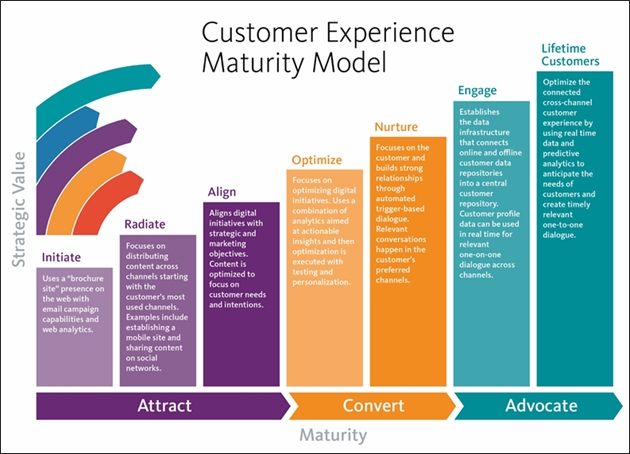What is context marketing? And what does it have to do with customer experience?
Context marketing gives you the power to understand your customers and offer them a truly personalized experience. It can help you deliver the right content or services to the right people at exactly the right time.
Organizations that market to customers in the context of those customers’ current and past interactions know exactly where customers are on the decision journey. More important, they can assess and figure out what might improve the customer journey and guide customers toward purchase.
However, few organizations are managing to market in context and effectively manage the customer experience. That’s because doing so requires investment in the right marketing technology and the dissolution of traditional silos-by-channel that exist in most marketing departments.
With the following approach, any organization can lay the foundation for success with its customer experience program, from the early stages of transformation to more mature stages of customer delight (see customer experience maturity model, below).
Align Your Marketing Roles With Customer Experience Maturity
Attract Phase
When developing a customer experience program, it’s best to start with a small, focused team, enabling you to achieve quick wins and deliver business impact. Staffing these roles can range from realigning existing resources to hiring new talent and virtually extending the team’s expertise through third-party solution vendors.
Key roles for the initial stages of customer experience program development include the following:
- Executive sponsor: Is an overall advocate for the customer experience initiative, resources, leadership commitment, and cross-organizational collaboration
- Customer experience leader: Leads the overall management of the program
- Digital strategist: Translates the organization’s overall strategy into customer experience strategy and tactics, mainly focused on digital touchpoints as the beginning of the program
- Content marketer: Leads journey-aligned content creation based on key customer segments, tactics, and experience flows across channels
- Marketing technologist: Executes and optimizes marketing tactics—hands-on within the marketing architecture for optimization and personalization
- UX designer: Is responsible for the overall user experience and information architecture
- Digital analyst: Provides insights into customer journeys and channel, campaign, and segment performance; develops recommendations for optimizing business results
- Technical architect: Helps to scope different CX initiatives involving different parts of the marketing architecture and helps coordinate sprints with technical teams
Convert Phase
When progressing into the Convert phase of customer experience maturity, the following key roles will enable your organization to gain more insights from customer data, manage the program as it scales, evolve the underlying marketing architecture, and customize the solution to enable your specific strategy:
- Experience architect: Designs the connected personalized experience across touchpoints and channels, with the focus on delighting the customer at every touch
- Data analyst: Uses the experience data to provide analysis, attribution, and predictive modeling to enable the team to maximize conversion paths, segment journeys, and transaction opportunities
Advocate Phase
Into the more advanced stages of customer experience maturity, your overall business and customer experience strategies will require specialized roles to enrich the team’s capabilities and solution experience:
- E-commerce and merchandising leader: In commerce-led business models, works as part of the customer experience team to identify customer information at purchase or abandonment to increase customer lifetime value
- Channel manager: Focuses on optimizing the customer experience across channels, understanding the best ways to engage specific segments at journey stages, and designs appropriate campaigns and tactics
- Chief experience officer: Owns the entire customer experience, across all touchpoints; focuses on nurturing customers for life; integrates all interactions across the customer experience
Organizational Models for Your Team
It takes a seamless organization to deliver a seamless customer experience. Your organization will need to shift from a structure of separate departments and silos to a culture that enables integration across all touchpoints of the customer experience.
For larger organizations needing to accelerate transformation, we have seen great success with “centers of excellence” (CoE), where a central core team can assist brands or units with the high-impact skills, cross-pollination of innovation, and shared expertise found in roles such as chief digital officer, digital strategists, experience architects, channel experts, as well as digital and data analysts.
Running Your Customer Experience Organization at Scale
Once your team is in place, as your overall business grows you’ll need to make sure your team and processes scale as well. To do so effectively, the following are among the elements you’ll want to have:
Agile program management processes: One of the most important requirements for customer experience progression has to do with how the team works. Customer experience programs require continuous change, testing, and evaluation cycles that produce repeated, iterative improvements. The Agile methodology, including the Scrum approach, provides the most effective organizational model to achieve this.
Key organizational development phases: It’s important to stay ahead of your execution timeline to allow for hiring cycles to secure the right skills.
Program governance: Customer experience programs require an Agile delivery model. Scaling the program across geographies and business units requires intentional governance process such as…
- A focus on specific business outcomes
- Experience performance standards
- Review with executive management
- Backlog prioritization
- Alignment of budget and resources to customer experience strategy
- Ongoing evaluation of program to plan KPIs
Steering committee: A cross-functional executive team determines how best to evolve and invest the customer experience program based on strategic priorities.
Putting It All Into Action
To successfully begin and progress through customer experience maturity, you need the right people, in the right roles, organized in the most appropriate model, working in an effective manner.
Once you’re able to determine where exactly your organization sits in the market, you must establish a tailored and focused team that possess the skills needed for the business goal you’re aiming for at that given time. When your team is in place, it’s important to organize a structure and processes that are scalable, flexible, and easy to replicate and implement across teams.
At the end of the day, building a winning customer experience starts with people—your own and your customers—and it can truly be jumpstarted by the power of context marketing.
–
This article first appeared in www.marketingprofs.com
Seeking to build and grow your brand using the force of consumer insight, strategic foresight, creative disruption and technology prowess? Talk to us at +9714 3867728 or mail: info@groupisd.com or visit www.groupisd.com





